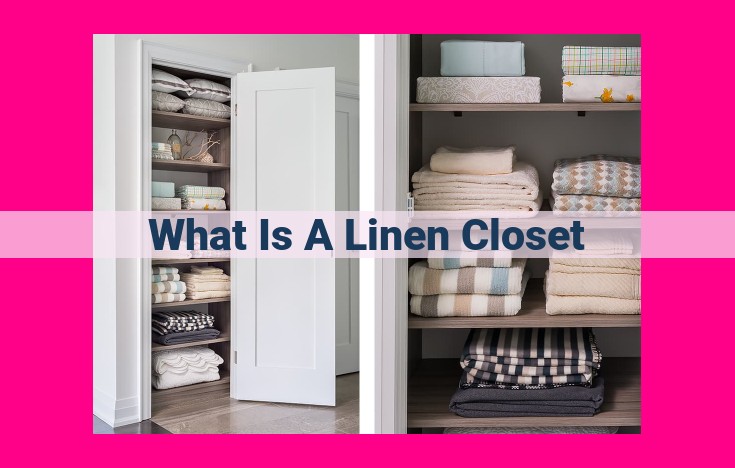Essential Linen Closet: The Ultimate Guide To Organizing And Storing Household Linen

A linen closet is a dedicated storage space specifically designed to organize and store household linen items like bedding, towels, and table linens. It typically features various organizational elements such as shelves, drawers, and hanging rods, allowing for efficient storage and easy access to these items. Linen closets are essential for maintaining an organized and tidy home, ensuring that linens are kept fresh, wrinkle-free, and readily available for daily use.
Essential Elements for Efficient Closet Organization: The Cornerstones of a Tidy Space
Every well-organized closet is a symphony of functionality and order, a sanctuary where belongings find their designated homes. To achieve this organizational nirvana, there are several fundamental components that act as the cornerstones of an efficiently designed closet space.
-
Adequate Hanging Space: A spacious hanging rod, or perhaps multiple rods, is crucial for accommodating an ample collection of clothes. Ensure ample space for hanging longer items like dresses, suits, and jackets, as well as shorter items like shirts, blouses, and skirts.
-
Foldable Shelves: Shelves provide versatile storage for folded garments, linens, and other items. Adjustable shelves allow for customization to accommodate items of varying heights, ensuring optimal space utilization.
-
Drawers for Delicates: Delicate items, such as lingerie, socks, and scarves, deserve a designated space to shield them from wrinkles and disarray. Drawers keep them neatly organized and easily accessible.
-
Stackable Bins: Stackable bins provide organized storage for bulky items like blankets, pillows, and seasonal clothing. They can also be labeled for easy identification, streamlining the retrieval process.
-
Hanging Organizers: Hanging organizers make use of vertical space by providing additional storage for small items like accessories, belts, and ties. They can be easily attached to the closet rod, maximizing space and keeping items within easy reach.
-
Lighting: Proper lighting is essential for navigating your closet with ease. Install bright and evenly distributed lighting to ensure clear visibility, making finding your favorite outfit a hassle-free task.
Closet Types: Choosing the Right Fit for Your Storage Needs
When it comes to organizing your closet, understanding the different types of closets available is crucial for maximizing space and efficiency. While each type has its own advantages, the best fit depends on the size of your space and your storage requirements.
Walk-in Closet: The Ultimate Storage Haven
If you have the luxury of ample space, a walk-in closet is the ultimate storage dream. These closets offer a private and spacious area where you can easily store and organize your entire wardrobe. With plenty of hanging space, shelving, and drawers, you can keep your clothes neatly organized and easily accessible.
Reach-in Closet: A Compact Space Maximizer
For smaller spaces, a reach-in closet is a practical storage solution. These closets usually have a single door that opens into a compact space. While they may not offer the same level of accessibility as walk-in closets, they can be efficiently organized with the use of shelves, hanging rods, and storage bins.
Wardrobe Closet: A Versatile Storage Option
A wardrobe closet combines the advantages of both walk-in and reach-in closets. These closets typically have a door that swings open to reveal a compact, yet surprisingly spacious storage area. They often include hanging space, shelves, and drawers, allowing you to maximize storage without sacrificing accessibility.
Ultimately, the best closet type for you depends on the size of your space, your storage requirements, and your personal preference. By considering these factors, you can choose the closet that perfectly complements your bedroom and helps you maintain an organized and clutter-free living space.
Linen Items: The Cornerstone of a Well-Organized Closet
Nestled amidst your wardrobe’s finest, linen items hold a special place in creating a comfortable and inviting closet space. From plush towels that envelop you in warmth to crisp sheets that promise a blissful night’s rest, these textiles deserve the utmost care and attention.
Proper storage of linen items is essential for maintaining their freshness, durability, and aesthetic appeal. Here are some key tips to help you organize your linen closet like a pro:
1. Folding and Stacking Mastery
The art of linen folding goes beyond mere crease lines. Proper folding techniques not only conserve space, but also prevent wrinkles and make items easier to find. For towels, try the “rolling” method, which reduces bulk and creates space-saving cylinders. Sheets, on the other hand, can be folded “hospital-style” for a neat and compact stack.
2. Vertical Space Optimization
Utilize vertical space in your closet by stacking folded items vertically. This allows you to maximize storage capacity and keep everything within easy reach. Shelves and drawer dividers can help you separate different types of linens and maintain a tidy appearance.
3. Vacuum-Sealing for Space Reduction
For seasonal bedding or infrequently used items, vacuum sealing is a fantastic space-saving solution. These airtight bags compress items to a fraction of their original size, freeing up valuable closet real estate.
4. The Power of Hanging
Hanging storage is an excellent option for delicate fabrics or items that wrinkle easily. Fabric hangers designed for specific items, such as skirt hangers or scarf hangers, help maintain their shape and prevent damage.
5. Keep it Fresh and Fragrant
To keep your linens smelling fresh and inviting, consider placing sachet bags filled with lavender or cedar wood in your closet. These natural scents deter pests and leave your linens smelling delightful.
The Power of Organizational Tools: Enhancing Closet Efficiency
In the realm of closet organization, the key to success lies in utilizing the right tools for the job. Shelves, drawers, hanging rods, and storage bins serve as the essential building blocks of an efficient and streamlined storage system.
Shelves: A Haven for Folded Garments
Shelves provide the perfect platform for organizing folded clothing, from T-shirts to sweaters. Choose shelves with adjustable heights to accommodate different stack sizes and maximize space. Utilize shelf dividers to keep folded items upright and prevent them from toppling over.
Drawers: A Place for Delicates and Valuables
Drawers are ideal for storing delicate items like undergarments, jewelry, and scarves. Choose drawers with smooth, gliding mechanisms to ensure easy access. Compartmentalize drawers using dividers to keep each type of item separated and organized.
Hanging Rods: The Workhorses of Closet Storage
Hanging rods are the backbone of any closet organization system. They provide ample space for hanging shirts, dresses, pants, and jackets. Opt for sturdy rods that can support the weight of your garments without bending or sagging. Consider double rods to maximize hanging space, especially in smaller closets.
Storage Bins: Tame the Clutter
Storage bins are versatile tools that can be used to store everything from shoes to bulky items like blankets and pillows. Choose bins with clear labels to quickly identify their contents. Utilize vertical space by stacking bins on shelves or using them in drawers for smaller items.
Materials: Striking a Balance Between Durability and Aesthetics
When it comes to closet organization systems, the materials you choose play a crucial role in both their functionality and aesthetic appeal. Each material offers unique benefits and drawbacks, so it’s important to consider your specific needs before making a decision.
Wood is a classic choice for closet organization, known for its durability, warmth, and timeless style. Wood shelves, drawers, and hanging rods can withstand heavy loads and provide a sturdy base for your belongings. However, solid wood can be more expensive than other materials and may require regular maintenance to prevent warping or damage.
Metal is a popular option for its strength and versatility. Metal shelves and rods are durable and can be adjusted to fit your storage needs. Metal is also rust-resistant, making it a suitable choice for humid environments. However, metal can be prone to scratches and dents, and it may not be the most visually appealing option.
Wire offers a lightweight and airy alternative to wood and metal. Wire shelves and baskets allow for easy visibility of your belongings and can help maximize space utilization. Wire is also relatively affordable and easy to install. However, it may not be as durable as wood or metal and may not be suitable for heavy items.
Plastic is a budget-friendly option that comes in a wide range of colors and styles. Plastic shelves, drawers, and bins are lightweight and easy to clean. However, plastic can be less durable than other materials and may not be able to withstand heavy loads. It may also be prone to cracking or fading over time.
Ultimately, the best material for your closet organization system will depend on your individual needs, preferences, and budget. Consider factors such as the size and shape of your closet, the items you need to store, and the overall aesthetic you want to achieve.
Tailoring Your Closet to Fit Your Unique Needs
Your closet should be a sanctuary, not a disorganized mess. To achieve that, it’s crucial to personalize it according to your storage needs and preferences. Consider these factors:
Hanging Space
How do you prefer to hang your clothes? Do you need more space for suits or dresses? Consider adding extra hanging rods or a double rod system to maximize vertical space.
Shelf Height
What do you store on your shelves? Adjust the shelf heights to accommodate different items, such as bulky sweaters or delicate accessories.
Drawer Dimensions
Choose drawers in various sizes to accommodate different types of clothing. Shallow drawers are ideal for socks and underwear, while deeper ones are perfect for larger items like blankets or seasonal wear.
Accessories
Don’t forget about accessories! Add shelves or drawer organizers to store belts, scarves, and jewelry neatly.
Seasonal Storage
If you have limited closet space, consider using vacuum storage bags to store seasonal items. This clever trick frees up valuable space until you need those items again.
Fold, Stack, and Store
Remember the importance of proper storage techniques. Fold clothes neatly using the KonMari method and stack them vertically to save space. Use clear bins or storage boxes to keep items organized and easily accessible.
By personalizing your closet and implementing smart storage solutions, you can transform it into an organized, functional, and stylish space that meets your unique needs.





